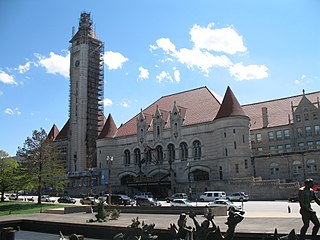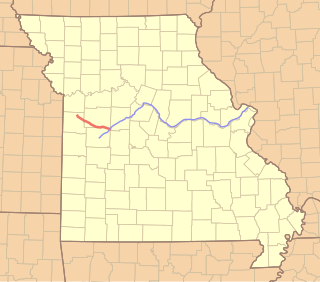| Overview | |
|---|---|
| Location | Under Missouri Route 17 at Eugene, Missouri |
| Coordinates | 38°21′08″N92°23′48″W / 38.352118°N 92.396704°W Coordinates: 38°21′08″N92°23′48″W / 38.352118°N 92.396704°W |
| System | Formerly the Chicago, Rock Island and Pacific railroad |
| Operation | |
| Opened | 1903 |
| Closed | 1980 |
| Technical | |
| No. of tracks | Single |
The Eugene Tunnel is a railway tunnel in Cole County, Missouri. It was built by the Chicago, Rock Island and Pacific Railroad (the Rock Island) in 1903, and is tunnel number three of four on this line from Kansas City to St. Louis, Missouri line. The tunnel is a pointed-arch shape, and goes west to east in direction.
Regular, daily service on this portion of the Rock Island's network ended in August, 1979, with the final train passing through the tunnel in December of that year. The Rock Island Railroad ceased operations entirely, and was liquidated, after March 31, 1980. Many court hearings, and wants of this line have happened over the years. Union Pacific Railroad originally owned the line after the Rock's bankruptcy. It then was sold to the Missouri Central Railroad. Later the MRC was bought by utility giant Ameren, which now owns the line.

North America's first transcontinental railroad was a 1,911-mile (3,075 km) continuous railroad line constructed between 1863 and 1869 that connected the existing eastern U.S. rail network at Council Bluffs, Iowa with the Pacific coast at the Oakland Long Wharf on San Francisco Bay. The rail line was built by three private companies over public lands provided by extensive US land grants. Construction was financed by both state and US government subsidy bonds as well as by company issued mortgage bonds. The Western Pacific Railroad Company built 132 mi (212 km) of track from the road's western terminus at Alameda/Oakland to Sacramento, California. The Central Pacific Railroad Company of California (CPRR) constructed 690 mi (1,110 km) east wm Sacramento to Promontory Summit, Utah Territory. The Union Pacific Railroad (UPRR) built 1,085 mi (1,746 km) from the road's eastern terminus at the Missouri River settlements of Council Bluffs and Omaha, Nebraska westward to Promontory Summit.

The Union Pacific Railroad, legally Union Pacific Railroad Company and simply Union Pacific, is a freight-hauling railroad that operates 8,300 locomotives over 32,200 miles (51,800 km) routes in 23 U.S. states west of Chicago and New Orleans. Union Pacific is the second largest railroad in the United States after BNSF. Union Pacific and BNSF have a duopoly on transcontinental freight rail lines in the Western United States.

The Chicago, Rock Island and Pacific Railroad was an American Class I railroad. It was also known as the Rock Island Line, or, in its final years, The Rock.

The Missouri Pacific Railroad, commonly abbreviated as MoPac, was one of the first railroads in the United States west of the Mississippi River. MoPac was a Class I railroad growing from dozens of predecessors and mergers. In 1967, the railroad operated 9,041 miles of road and 13,318 miles of track, not including DK&S, NO&LC, T&P, and its subsidiaries C&EI and Missouri-Illinois.

The Central Oregon and Pacific Railroad is a Class II railroad operating between Northern California and Eugene, Oregon, United States. It was previously a mainline owned by the Southern Pacific Railroad (SP) between Eugene and Weed, California via Medford, Oregon. SP sold the route on December 31, 1994, in favor of using its route to Eugene via Klamath Falls, Oregon and Cascade Summit.

The Wichita, Tillman and Jackson Railway is a shortline railroad subsidiary of the Rio Grande Pacific Corporation that operates two disconnected lines in Oklahoma and Texas, mostly owned by the state of Oklahoma. The line for which it is named extends from Wichita Falls, Texas to Altus, Oklahoma, through Wichita, Tillman, and Jackson Counties. It was completed by the Wichita Falls and Northwestern Railway and Wichita Falls and Northwestern Railway of Texas in 1910, and became part of the Missouri, Kansas and Texas Railway (MKT) system in 1911. The line was cut back from Forgan, in the Oklahoma Panhandle, to Altus in 1973, and operations were transferred to the WTJR in January 1991. The other line, from Waurika to Walters, is a former Chicago, Rock Island and Pacific Railroad branch, leased to the Oklahoma, Kansas and Texas Railroad, an MKT subsidiary, after the Rock Island's abandonment in 1980, and transferred to the WTJR in 1991.

The Terminal Railroad Association of St. Louis is a switching and terminal railroad that handles traffic in the St. Louis, Missouri, metropolitan area. It is co-owned by several Class I railroads that reach the city.

The National Museum of Transportation (NMOT) is a private, 42-acre transportation museum in the Kirkwood suburb of St. Louis, Missouri. Founded in 1944, it restores, preserves, and displays a wide variety of vehicles spanning 15 decades of American history: cars, boats, aircraft, and in particular, locomotives and railroad equipment from around the United States. The museum is also home to a research library of transportation-related memorabilia and documents.
The Oklahoma, Kansas and Texas Railroad (OKT) was a railroad operating in its namesake states in the 1980s.

The Kansas City Terminal Railway is a Class III terminal railroad that serves as a joint operation of the trunk railroads that serve the Kansas City metropolitan area, the United States' second largest rail hub after Chicago. It is operated by the Kaw River Railroad.

The Mississippi and Missouri Railroad was the first railroad in Iowa. It was chartered in 1853 to build a line between Davenport, Iowa, on the Mississippi River and Council Bluffs, Iowa, on the Missouri River. The railroad was the first west of the Mississippi river to join by bridge to the East. It played an important role in the construction of the First Transcontinental Railroad. The competing Cedar Rapids and Missouri River Railroad actually became the first Iowa railroad to reach Council Bluffs from the Mississippi River. Thomas C. Durant, vice president of the Union Pacific Railroad, owned stock in both.
The Beaumont, Sour Lake and Western Railway was an 85-mile (137 km) railroad that ran from Beaumont, Texas to Gulf Coast Junction in Houston. It passed through small southeast Texas communities such as Hull, Kenefick, and Huffman. As part of the Gulf Coast Lines system, the road was eventually merged into the Missouri Pacific Railroad in 1956, which in turn was merged into the Union Pacific Railroad in 1982. The Union Pacific still makes heavy use of the route.
The Vale Tunnel is a railway tunnel south of Raytown, near Kansas City, Missouri. It was built by the Chicago, Rock Island and Pacific railroad in 1903-04, and was the final tunnel of four to be built on the entire Rock Island railroad, all of which were in Missouri. The tunnel is part of the Kansas City to St. Louis, Missouri line, and travels beneath Bannister Road. In 1980, the Rock Island was liquidated in court and the tunnel and line across Missouri was eventually sold to the St. Louis Southwestern Railway.
The Koeltztown Tunnel is a railway tunnel in Osage County, Missouri. It was built in 1903 by the Chicago, Rock Island and Pacific railroad. The tunnel is part of the former Kansas City to St. Louis, Missouri line, and is tunnel two of four. The line was once owned by the Missouri Central Railroad, but now is owned by the utility giant Ameren.
The Freeburg Tunnel is a railway tunnel in Missouri. Construction on what was then the St. Louis, Kansas City and Colorado Railroad began in 1901. It was completed in 1903 by the Chicago, Rock Island and Pacific Railroad, and abandoned in 1980. The tunnel is part of the Kansas City to St. Louis, Missouri line. This is tunnel number one of four on this line.

The Overland Route was a train route operated jointly by the Union Pacific Railroad and the Central Pacific Railroad / Southern Pacific Railroad, between Council Bluffs, Iowa / Omaha, Nebraska, and San Francisco, California, over the grade of the first transcontinental railroad which had been opened on May 10, 1869. Passenger trains that operated over the line included the Overland Flyer, later renamed the Overland Limited, which also included a connection to Chicago. Although these passenger rail trains are no longer in operation, the Overland Route remains a common name for the line from Northern California to Chicago, now owned entirely by the Union Pacific.
The Central Midland Railway, a division of Progressive Rail Incorporated of Lakeville, Minnesota, is a short line railroad in the U.S. state of Missouri, operating under lease of the former St. Louis Subdivision of the Chicago, Rock Island and Pacific Railroad. CMR operates the easternmost 60 miles of the 298-mile Rock Island line which used to stretch from St. Louis to Kansas City, Missouri. Today, CMR's operation of the line is performed under two separate leases from the Union Pacific Railroad and the A&K Railroad Materials Corp, respectively, from Overland, Missouri - a suburb of St. Louis, to a location just west of Union, Missouri. CMR's first leased-segment is Union Pacific's "Lackland Subdivision" which extends from "Rock Island Junction" near the intersection of Page Avenue and I-170 in Overland to a location on the north-side of Creve Coeur Lake in Maryland Heights, Missouri, known as "Vigus." The second leased-segment is owned by A&K Railroad Materials and extends from Vigus to just east of Beaufort, Missouri, with active service terminating at Union.
The following is a brief history of the North American rail system, mainly through major changes to Class I railroads, the largest class by operating revenue.

The Rock Island Spur of Katy Trail State Park is a state park in the U.S. state of Missouri that is 47-mile (76 km) rails to trails hiking and biking trail. Work on the trail was completed and the trail was opened on December 10, 2016. The trail provides residents of the Kansas City region direct trail access to the 240 mi (390 km) Katy Trail State Park, the longest rails to trails trail in the U.S. The Rock Island Trail uses "abandoned" right-of-way of the Chicago, Rock Island and Pacific Railroad between Pleasant Hill in Cass County and Windsor in Henry County where it meets the Katy Trail.
Medford is an unincorporated community in southern Johnson County in the U.S. state of Missouri.